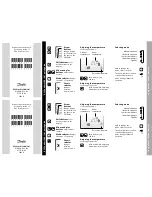
10-2
L90 LINE CURRENT DIFFERENTIAL SYSTEM – INSTRUCTION MANUAL
OVERVIEW
CHAPTER 10: THEORY OF OPERATION
10
The third major element of L90 design is sampling synchronization. In order for a differential scheme to work, the data
being compared must be taken at the same time. This creates a challenge when data is taken at remote locations.
The GE approach to clock synchronization relies upon distributed synchronization. Distributed synchronization is
accomplished by synchronizing the clocks to each other rather than to a master clock. Clocks are phase-synchronized to
each other and frequency-synchronized to the power-system frequency. Each relay compares the phase of its clock to the
phase of the other clocks and compares the frequency of its clock to the power-system frequency and makes appropriate
adjustments. As long as there are enough channels operating to provide protection, the clocks are synchronized.
10.1.2 L90 architecture
The L90 system uses a peer-to-peer architecture in which the relays at every terminal are identical. Each relay computes
differential current and clocks are synchronized to each other. The peer-to-peer architecture is based on two concepts that
reduce the dependence of the system on the communication channels: replication of protection and distributed
synchronization.
Replication of protection means that each relay is designed to be able to provide protection for the entire system and does
so whenever it has enough information. Thus a relay provides protection whenever it is able to communicate directly with
all other relays. For a multi-terminal system, the degree of replication is determined by the extent of communication
interconnection. If there is a channel between every pair of relays, every relay provides protection. If channels are not
provided between every pair of relays, only those relays that are connected to all other relays provide protection.
Each L90 relay measures three phase currents 64 times per cycle. Synchronization in sampling is maintained throughout
the system via the distributed synchronization technique.
The next step is the removal of any decaying offset from each phase current measurement. This is done using a digital
simulation of the so-called “mimic circuit” (based on the differential equation of the inductive circuit that generates the
offset). Next, phaselets are computed by each L90 for each phase from the outputs of the mimic calculation and
transmitted to the other relay terminals. Also, the sum of the squares of the raw data samples is computed for each phase,
and transmitted with the phaselets.
At the receiving relay, the received phaselets are combined into phasors. Also, ground current is reconstructed from phase
information. An elliptical restraint region is computed by combining sources of measurement error. In addition to the
restraint region, a separate disturbance detector is used to enhance security.
The possibility of a fault is indicated by the detection of a disturbance as well as the sum of the current phasors falling
outside of the elliptical restraint region. The statistical distance from the phasor to the restraint region is an indication of
the severity of the fault. To provide speed of response that is commensurate with fault severity, the distance is filtered. For
mild faults, filtering improves measurement precision at the expense of a slight delay, on the order of one cycle. Severe
faults are detected within a single phaselet. Whenever the sum of phasors falls within the elliptical restraint region, the
system assumes there is no fault and uses whatever information is available for fine adjustment of the clocks.
10.1.3 Removal of decaying offset
The inductive behavior of power system transmission lines gives rise to decaying exponential offsets during transient
conditions, which can lead to errors and interfere with the determination of how well measured current fits a sinewave.
The current signals are pre-filtered using an improved digital MIMIC filter. The filter removes the DC component(s),
guaranteeing transient overshoot below 2% regardless of the initial magnitude and time constant of the DC component(s).
The filter has significantly better filtering properties for higher frequencies as compared with a classical MIMIC filter. This is
possible without introducing any significant phase delay due to the high sampling rate used by the relay. The output of the
MIMIC calculation is the input for the phaselet computation. The MIMIC computation is applied to the data samples for
each phase at each terminal. The equation shown is for one phase at one terminal.
10.1.4 Phaselet computation
Phaselets are partial sums in the computation for fitting a sine function to measured samples. Each slave computes
phaselets for each phase current and transmits phaselet information to the master for conversion into phasors. Phaselets
enable the efficient computation of phasors over sample windows that are not restricted to an integer multiple of a half
cycle at the power system frequency. Determining the fundamental power system frequency component of current data
Содержание L90
Страница 14: ...1 4 L90 LINE CURRENT DIFFERENTIAL SYSTEM INSTRUCTION MANUAL FOR FURTHER ASSISTANCE CHAPTER 1 INTRODUCTION 1 ...
Страница 68: ...2 54 L90 LINE CURRENT DIFFERENTIAL SYSTEM INSTRUCTION MANUAL SPECIFICATIONS CHAPTER 2 PRODUCT DESCRIPTION 2 ...
Страница 136: ...3 68 L90 LINE CURRENT DIFFERENTIAL SYSTEM INSTRUCTION MANUAL CONNECT TO D400 GATEWAY CHAPTER 3 INSTALLATION 3 ...
Страница 224: ...4 88 L90 LINE CURRENT DIFFERENTIAL SYSTEM INSTRUCTION MANUAL FLEXLOGIC DESIGN USING ENGINEER CHAPTER 4 INTERFACES 4 ...
Страница 692: ...6 36 L90 LINE CURRENT DIFFERENTIAL SYSTEM INSTRUCTION MANUAL PRODUCT INFORMATION CHAPTER 6 ACTUAL VALUES 6 ...
Страница 708: ...7 16 L90 LINE CURRENT DIFFERENTIAL SYSTEM INSTRUCTION MANUAL TARGETS MENU CHAPTER 7 COMMANDS AND TARGETS 7 ...
Страница 742: ...9 6 L90 LINE CURRENT DIFFERENTIAL SYSTEM INSTRUCTION MANUAL TESTING CHAPTER 9 COMMISSIONING 9 ...
Страница 804: ...10 62 L90 LINE CURRENT DIFFERENTIAL SYSTEM INSTRUCTION MANUAL FAULT LOCATOR CHAPTER 10 THEORY OF OPERATION 10 ...
Страница 872: ...C 6 L90 LINE CURRENT DIFFERENTIAL SYSTEM INSTRUCTION MANUAL COMMAND LINE INTERFACE APPENDIX C COMMAND LINE INTERFACE C ...
Страница 878: ...D 6 L90 LINE CURRENT DIFFERENTIAL SYSTEM INSTRUCTION MANUAL REVISION HISTORY APPENDIX D MISCELLANEOUS D ...
Страница 882: ...iv L90 LINE CURRENT DIFFERENTIAL SYSTEM INSTRUCTION MANUAL ABBREVIATIONS ...
Страница 900: ...xviii L90 LINE CURRENT DIFFERENTIAL SYSTEM INSTRUCTION MANUAL INDEX ...
















































